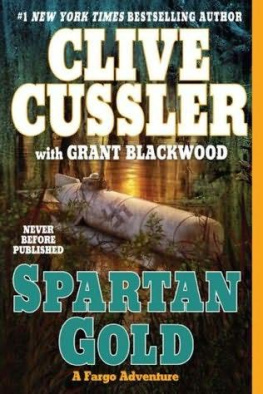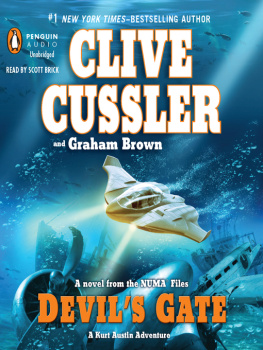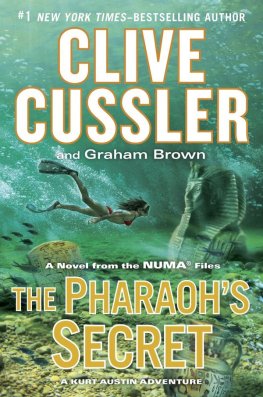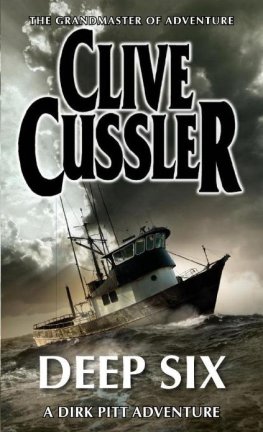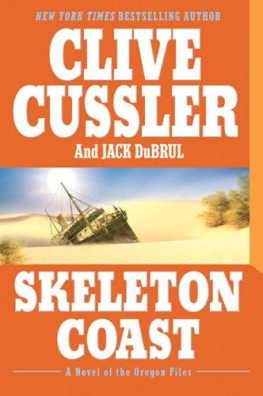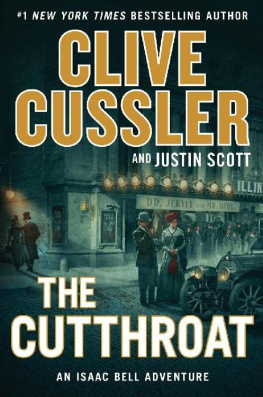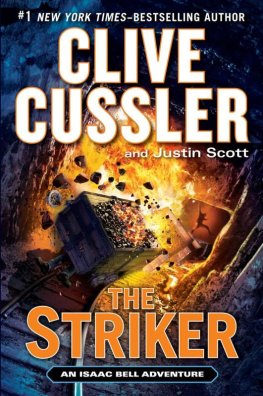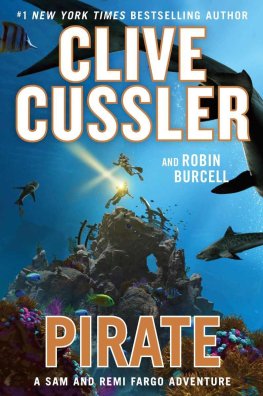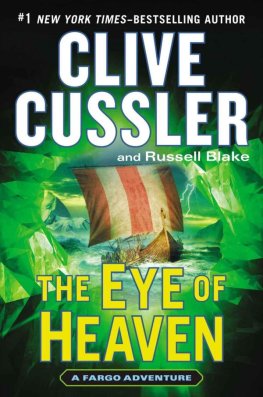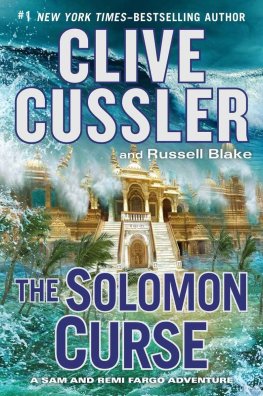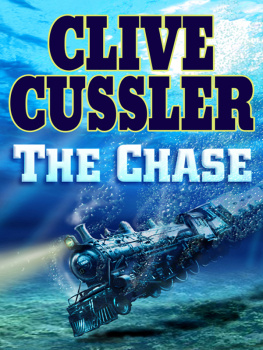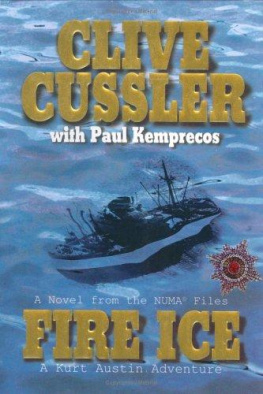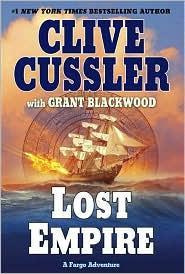CHAPTER 1
GREAT POCOMOKE SWAMP, MARYLAND PRESENT DAY
Sam Fargo rose from his crouch and glanced over at his wife, who stood up to her waist in oozing black mud. Her bright yellow chest waders complemented her lustrous auburn hair. She sensed his gaze, turned to him, pursed her lips, and blew a wisp of hair from her cheek. And just what are you smiling at, Fargo? she asked.
When shed first donned the waders hed made the mistake of suggesting she looked like the Gortons Fisherman, which had earned him a withering stare. Hed hastily added sexy to the description, but to little effect.
You, he now replied. You look beautifulLongstreet. When Remi was annoyed at him she called him by his last name; he always responded in kind with her maiden name.
She held up her arms, coated to the elbows in slime, then said with a barely concealed smile, Youre crazy. My face is covered in mosquito bites, and my hair is flatter than paper. She scratched her chin, leaving behind a dollop of mud.
It simply adds to your charm.
Liar.
Despite the look of disgust on her face, Sam knew Remi was a trouper without peer. Once she set her mind on a goal, no amount of discomfort would dissuade her.
Well, she said, I have to admit, you do look rather dashing yourself.
Sam tipped his tattered Panama hat at her, then went back to work, scooping mud from around a length of submerged wood he hoped was part of a chest.
For the past three days theyd been plodding through the swamp, searching for that one clue that might prove they werent on a wild-goose chase. Neither of them minded a good goose chasein treasure hunting it came with the turfbut it was always better to catch the goose in the end.
In this case, the goose in question was based on an obscure legend. While the nearby Chesapeake and Delaware bays were said to be home of nearly four thousand shipwrecks, the prize Sam and Remi were after was land based. A month earlier Ted Frobisher, a fellow treasure hunter whod retired not long ago to concentrate on his antique shop in Princess Anne, had sent them a brooch with an intriguing provenance.
The pear-shaped gold and jade brooch was said to have belonged to a local woman named Henrietta Bronson, one of the first victims of the notorious outlaw Martha Patty (a.k.a. Lucretia) Cannon.
According to legend Martha Cannon was a tough, ruthless woman who in the 1820s not only stalked the wilds of the Delaware-Maryland border with her gang, robbing and murdering the wealthy and poor alike, but who also ran a hostel in what was then called Johnsons Corners, today Reliance.
Cannon would lure travelers into her establishment and feed, entertain, and tuck them in to bed before murdering them in the middle of the night. She would drag the bodies into the basement, take anything of value, then stack them in the corner like cordwood until shed accumulated enough to warrant a wagon trip to a nearby forest, where she would bury them en masse. Horrific as that was, Cannon would later commit what many considered her most heinous crimes.
Cannon established what many local historians had dubbed a reverse underground railroad, kidnapping freed southern slaves and keeping them bound and gagged in the inns many secret rooms and its makeshift earthen dungeon before sneaking them in the dark of the night to Cannons Ferry, where they would be sold and loaded onto ships headed down the Nanticoke River bound for Georgias slave markets.
In 1829, while plowing a field on one of Cannons farms, a worker uncovered several partially decomposed bodies. Cannon was speedily indicted on four counts of murder, found guilty, and sentenced to prison. Four years later she died in her cell by what most agreed was suicide by arsenic.
In subsequent years both Cannons crimes and her ultimate demise grew in myth, ranging from the claim that Cannon had escaped from prison and went on murdering and robbing far into her nineties, to tales that have her ghost still roaming the Delmarva Peninsula, waylaying unsuspecting hikers. What few people disputed was that Cannons lootof which shed reportedly spent only a fractionhad never been recovered. Estimates put the treasures present-day value somewhere between $100,000 and $400,000.
Sam and Remi had of course heard the legend of Patty Cannons treasure, but lacking solid leads theyd consigned it to the someday file. With the emergence of Henrietta Bronsons brooch and an exact datum with which to begin their search, theyd decided to tackle the mystery.
After a detailed study of the Pocomokes historical topography and mapping Cannons alleged hideouts in comparison to where the brooch had been found, theyd narrowed their search grid to a two-square-mile area, most of which lay deep within the swamp, a labyrinth of moss-draped cypress trees and brush-choked bogs. According to their research this area, which in the 1820s had been dry ground, had been home to one of Cannons hideouts, a tumble-down shack.
Their interest in Cannons treasure had nothing to do with the moneyat least not for their own benefit. Upon first hearing the story, Sam and Remi agreed if they were ever lucky enough to find the treasure, the bulk of the proceeds would go to the National Underground Railroad Freedom Center in Cincinnati, Ohio, an irony they felt sure would outrage Cannon if she were still alive. Or, if they were lucky, it would outrage her ghost.
Remi, what was that poem... the one about Cannon? Sam called. Remi had a near-photographic memory for details, both obscure and pertinent.
She thought for a moment, then recited:
Hush your mouth
Go to sleep
Old Patty Ridenour take you back deep
Got a gang of seven
Taking slave and free
Riding day and night
On her coal-black steed.
Thats it, Sam replied.
Around them the exposed roots of the cypress trees jutted from the water like disembodied talons of some great winged dinosaur. The previous week a storm had blown across the peninsula, leaving behind mounds of branches like hastily constructed beaver dams. Overhead, the canopy was alive with a symphony of squawks and buzzes and fluttering wings. Occasionally Sam, a part-time bird-watcher, would isolate a trilling and announce the birds name to Remi, who would humor him with a smile and a Thats very nice.
Sam found the exercise helped his by ear piano playing, something hed picked up from his mother. For her part, Remi had a nice touch with the violin, which she put to good use during their frequent impromptu duets.
Despite his engineering background, Sam was an intuitive, right-brain thinker, while Remi, a Boston College-trained anthropologist /historian, was firmly grounded in logical, left-brain thinking. While the dichotomy made them a balanced, loving pair, it also led to vigorous debates, ranging in topic from what had started the English Reformation to which actor made the best James Bond to how to best play Vivaldis concerto Summer. Most often the debates ended in laughter and an ongoing but good-natured disagreement.
Bent at the waist, Sam probed underwater with his fingers, sliding along the wood until he touched something metal... something with a U-shaped hasp and a square body.
A padlock, he thought, visions of an ancient barnacle-encrusted hasp swirling through his mind. Got something, he announced.
Remi turned toward him, muddy arms hanging by her sides.
Hah! Sam pulled it from the water. As the mud slid off and plopped back into the water, he saw the glint of rust and silver, then some raised letters....
M-A-S-T-E-R L-O-C-K.
Well? Remi said, her voice tinged with skepticism. She was used to Sams sometimes premature excitement.

